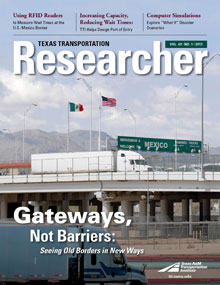Ninety-four percent of Texas drivers and their front-seat passengers are buckled up. It’s the largest compliance percentage since researchers with the Texas A&M Transportation Institute (TTI) began tracking compliance in 1992. By comparison, the 2011 use rate was 93.7 percent, up from 80 percent 10 years ago and 68 percent in 1992.
“It’s a fact that safety-belt use saves lives,” says TTI Senior Research Scientist Katie Womack, who manages TTI’s Behavioral Research Group. “For every increment of improvement in belt use, the rate of fatalities goes down. That’s why it’s very useful to know what the level of use is in Texas.”
Womack conducted numerous other surveys in 2012, the results of which show that improvement is still needed. In an 18-city study of nighttime safety-belt use, only 81 percent of drivers and their front-seat occupants were wearing a safety belt. That figure compares to an 89 percent use rate in the same cities during daylight hours. (The survey marks the first time TTI monitored safety-belt use for all hours of the night, not just the early hours of the evening.)

“In our previous nighttime surveys, which occurred during the early hours of darkness, there was not much of a difference compared to daytime safety-belt use,” Womack points out. “There’s a steady decrease in the rate of use after midnight. I think we now have a clearer picture of what’s taking place. In some cities, seat-belt use drops into the 60 percent range during some hours.”
Womack’s surveys help the Texas Department of Transportation (TxDOT) determine where safety campaigns need to be targeted in an effort to reduce the state’s fatality and injury rate. “Recently, the number of fatalities in Texas has been on a downward trend,” says TxDOT Traffic Safety Director Terry Pence. “Unfortunately, it appears that the number will be higher in 2012, based on our preliminary figures. I think it’s very clear that if every driver and passenger wore a safety belt day and night, the numbers of deaths and serious injuries would go down.”
In a survey of child-restraint use, Womack’s team found that 89 percent of the children riding in passenger cars were restrained (either by a seat belt or a child safety seat). However, the number dropped to 85 percent when the children were riding in a pickup truck. Comparing individual cities, child-restraint use varied from 97 percent in Austin to 77 percent in Corpus Christi. Regarding motorcycles, only 61 percent of 910 observed riders were wearing a helmet. A series of final reports on numerous unique surveys relating to occupant safety restraints has been submitted to TxDOT.



